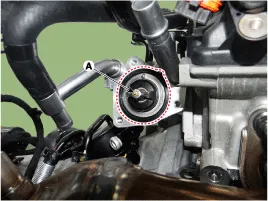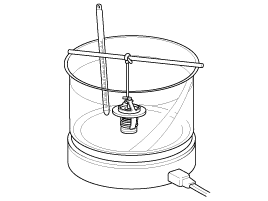Hyundai Genesis (DH): Cooling System / Thermostat Repair procedures
Hyundai Genesis (DH) 2013-2016 Service Manual / Engine Mechanical System / Cooling System / Thermostat Repair procedures
| Removal and Installation |
Removal of the thermostat will have an adverse effect, leading to lowered cooling efficiency.
Do not remove the thermostat, even if the engine tends to overheat. |
| 1. |
Disconnect the battery "-" terminal from the trunk room. |
| 2. |
Drain engine coolant so its level is below thermostat.
(Refer to Cooling System - "Coolant") |
| 3. |
Remove the water inlet pipe.
(Refer to Cooling System - "Water Temperature Control Assembly") |
| 4. |
Remove the coolant inlet fitting (A).
|
| 5. |
Remove the thermostat (A).
|
| 6. |
To install, reverse the removal procedure. |
| Inspection |
| 1. |
Immerse the thermostat in water and gradually heat the water.
|
| 2. |
Check the valve opening temperature.
Components 1. Water temperature control Assembly2. Thermostat3. Coolant inlet fitting Troubleshooting SymptomsPossible CausesRemedyCoolant leakage Other information:Hyundai Genesis (DH) 2013-2016 Service Manual: Compressor oil Repair proceduresOil Specification 1. The HFC-134a system requires synthetic (PAG) compressor oil whereas the R-12 system requires mineral compressor oil. The two oils must never be mixed. 2. Compressor (PAG) oil varies according to compressor model. Be sure to use oil specified for the compressor model. Hyundai Genesis (DH) 2013-2016 Service Manual: Condenser Repair proceduresInspection 1. Check the condenser fins for clogging and damage. If they are clogged, clean them with water, and blow them with compressed air. If they are bent, gently bend them using a screwdriver or pliers. 2. Check the condenser connections for leakage, and repair or replace it, if required. Categories
Copyright © 2025 www.hgenesisdh.com - 0.0194
|




